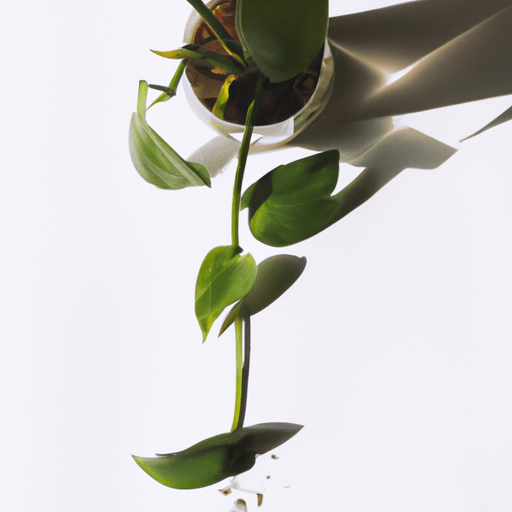The Chinese money plant, also known as Pilea Peperomioides, is a popular houseplant known for its unique round leaves and easy care requirements.
In this article, readers will discover essential care tips for ensuring the plant thrives in their homes.
From providing the right amount of light and choosing the perfect soil mix to understanding watering guidelines and propagation techniques, this article will equip readers with the knowledge they need to successfully care for their Chinese money plant.
Importance of Proper Lighting
Proper lighting is crucial for the care of a Chinese money plant. It thrives in medium to bright indirect light and should be rotated regularly to ensure even exposure.
Indirect light provides several benefits to the plant. It prevents leaf burn and promotes healthy growth. To create a suitable lighting environment, place the plant near a bright window. However, direct sunlight should be avoided as it can scorch the leaves.
If natural light is limited, artificial grow lights can be used to supplement the plant’s lighting needs. When positioning the plant, it is important to rotate it regularly. This prevents it from leaning towards the light source and ensures that all parts receive equal exposure.
Choosing the Right Soil Mix
To ensure healthy growth, it’s important to select a soil mix that is rich, well-draining, and contains high-quality organic potting mix. The right soil mix for a Chinese money plant, also known as Pilea peperomioides, will provide the necessary nutrients and drainage for optimal plant health.
When choosing a pot size, it’s important to consider the size of the plant and its root system. A pot that is too small may restrict root growth, while a pot that is too large can retain too much moisture, leading to root rot.
Additionally, using organic fertilizers can help promote healthy growth and provide essential nutrients for the Chinese money plant. Organic fertilizers are derived from natural sources and can provide a slow-release of nutrients over time, ensuring consistent and balanced nutrition for the plant.
Watering Guidelines for Chinese Money Plant
The Chinese money plant benefits from regular watering, allowing the soil to almost completely dry out between waterings. Watering frequency is an important aspect of caring for this plant. It is recommended to water the Chinese money plant when the top inch of soil feels dry to the touch.
Overwatering can lead to root rot and other problems, so it’s important to avoid keeping the soil consistently moist. Signs of overwatering include yellowing leaves, wilting, and a strong, unpleasant odor coming from the soil. If these signs are observed, it is best to reduce watering and allow the plant to dry out.
Proper watering is crucial for the health and well-being of the Chinese money plant, ensuring that it thrives and continues to bring its unique beauty to any indoor space.
Step-by-Step Guide to Propagation
When propagating the Pilea Peperomioides, it is important to separate offshoots when they reach a height of a few inches and plant them in moist soil.
Propagation techniques for the Pilea Peperomioides involve carefully removing the offshoots from the parent plant and ensuring they have enough room to grow independently. Once the offshoots are separated, they should be planted in a well-draining soil mix that is kept consistently moist.
It is important to provide adequate light and avoid overwatering during the propagation process. Caring for offshoots involves providing them with the same care as mature plants, including medium to bright indirect light, regular watering, and a suitable temperature and humidity level.
Preventing and Treating Common Pests
Inspecting the Pilea Peperomioides regularly for signs of infestation and promptly treating any common houseplant pests is essential for maintaining the plant’s health. Signs of pest infestation may include wilting leaves, yellowing or browning of leaves, sticky residue on leaves or surrounding areas, or the presence of small insects such as aphids or spider mites.
To prevent and treat common pests, natural pest control methods can be employed. These include using insecticidal soap or neem oil to kill pests on contact, wiping leaves with a solution of water and mild dish soap to remove pests and their eggs, or introducing beneficial insects such as ladybugs or predatory mites to eat the pests.
Troubleshooting: Leaf Care and Discoloration
Regularly checking the leaves for any signs of discoloration and addressing the issue promptly is crucial for maintaining the health of the Pilea Peperomioides.
Leaf discoloration in Chinese money plants can be caused by various factors. Overwatering is a common cause, leading to root rot and yellowing of leaves. Underwatering, on the other hand, can result in dry and brown edges.
Exposure to direct sunlight can cause scorched or faded leaves, while lack of light can lead to pale and leggy growth. To revive a dying Chinese money plant, it is important to identify the underlying issue and make appropriate adjustments.
This may involve adjusting watering frequency, providing adequate light, or repotting the plant in fresh, well-draining soil. Regular care and attention can help restore the health and vibrancy of the Pilea Peperomioides.
Expert Tips for Successful Care and Maintenance
To ensure successful care and maintenance of Pilea Peperomioides, experts recommend adjusting watering frequency based on the plant’s needs, providing adequate light, and using well-draining soil. Here are some expert tips for taking care of your Chinese money plant:
-
Watering:
-
Adjust the watering frequency based on the plant’s needs.
-
Allow the soil to dry out slightly between waterings to prevent overwatering.
-
Light:
-
Place the plant in a location with medium to bright indirect light.
-
Rotate the plant regularly to ensure even growth.
-
Soil:
-
Use a well-draining soil mix to prevent waterlogging.
-
Consider adding perlite to improve drainage.
In addition to these care tips, it is important to note that Pilea Peperomioides may benefit from seasonal care, such as pruning techniques to promote healthy growth and removing any dead or yellowing leaves.







